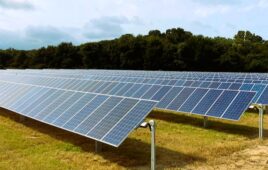When it comes to solar projects, the main goal is producing as much energy in as little space as possible. That’s why high-efficiency solar panels thrive in the residential market, where ideal roof space is sometimes limited.
While traditional solar panels average around 16 to 17% efficiency, modules labeled “high-efficiency” are at least 19% efficient. Many brands, including SunPower, are pushing their high-efficiency modules to 22% and higher. The main benefit of higher-efficiency modules is greater, more reliable power yield. Efficient cells produce more power over a longer period of time, and the advanced production methods panel manufacturers use to get higher efficiencies often lead to a more dependable product.
Increased power and efficiency also means an increased panel price, but Suvi Sharma, CEO of high-efficiency panel manufacturer Solaria, said the more powerful modules can actually save money in the bigger picture.
“Solaria PowerXT modules produce more power per square-meter area,” Sharma said. “This reduces installation costs due to fewer balance-of-system components.
“System costs are highly dependent on the power density of solar panels,” he continued. “Other system costs, such as labor, land and inverters, are not going down over time, so the most significant lever to reduce costs is to increase the efficiency of the panels.”
Manufacturers increase efficiency in a number of ways. Solaria doesn’t use busbars or ribbon interconnections and places its cells closer together, reducing inactive space between the cells. This leads to higher power and efficiency. SunPower and LG use back-contact technology which makes all electrical contacts on the back of the cell and creates maximum space on the front to capture more energy. Panasonic uses 5-in. solar cells instead of 6-in. cells (which are more common in the industry). This allows Panasonic to use 96 cells in the same footprint as a tradition 60-cell module. Smaller cells are more reliable, and there are fewer chances for microcracks and decreased output over time.
If high-efficiency modules are so great, why aren’t they being used across the board? Mukesh Sethi, general manager of the solar and energy storage division at Panasonic, said larger projects don’t usually use high-efficiency modules because stakeholders are more concerned about overall costs.
“They would not spend extra money on high-efficiency modules,” Sethi said of commercial rooftop installations and large ground-mounts. “If there’s more than enough space, they don’t need high-efficiency modules.”
When shading or other obstacles prevent a consistent stream of sunlight, production has to be maximized in the few spots where panels can be successfully mounted. On tricky sloped roofs where only four solar panels might work, more expensive high-efficiency brands are trusted to generate more power.
“Failures usually happen after 10 years with traditional modules,” Sethi said. “Everyone gives a 25-year warranty, but [is that manufacturer] going to be around in 25 years? Saving X amount of dollars [using traditional modules] isn’t even worth it.”
Sethi said that Panasonic’s high-efficiency modules have the same nameplate watt-rating as traditional modules, but high-efficiency modules have better performance and less degradation, so they’ll produce more, higher power over an extended period of time.
“The [watt] label is not everything,” he said. “[High-efficiency modules] have much more savings in the long run.”






They would not spend extra money on high-efficiency modules,” Sethi said of commercial rooftop installations and large ground-mounts. “If there’s more than enough space, they don’t need high-efficiency modules
Joe, do you have a link to the Lawrence Berkeley research you mentioned? Would like to understand more on the topic of solar efficiency gains as related to ROI.
Efficiency is the big lever but dollar per Watt effective – the Watts out average for a lifetime (approximately *(100% -*/2) at operating temperature (not same as 25 C label rating) – is the more important number; consequently, lifetime/reliability, thermal constant and efficiency loss over time are all important factors. In other words, the efficiency number to consider is efficiency at half-lifetime and average operating temperature. In higher latitudes, the practical seasonal variation in output is not as extreme as one might assume as high summer operating temperature lowers efficiency while low winter temperature is beneficial; there’s also a seasonal difference in atmospheric clarity.
For a commercial installation other factors such as land cost and taxation, labor cost, accessibility, low light performance (especially with trackers), cost of borrowing, etc can influence the economics (IRR calculation) and bankability. Also, terrain can come into it: land sloping to the south at high altitude with low average daytime temperatures is desirable. One structural factor to consider is whether framing design permits drainage which facilitates washing of glazing and shedding of precipitation and debris; obviously, so called self-cleaning glazing is also desirable. Obviously, panels that are difficult to keep clear are problematic regardless of efficiency. A reasonably accurate IRR model is/should be complex.
Lawrence Berkeley just released a report on the cost of solar showing the price premium of high efficiency solar panels (greater than 19 %) well outweighs the reduction in BOS, and cost significantly more per watt installed compared to lower efficiency panels. So if space is not a constraint, you pay a premium, not the same due to lower BOS. It would be interesting to see if they have less production drop over the long run so they could make up the premium you pay upfront at install.